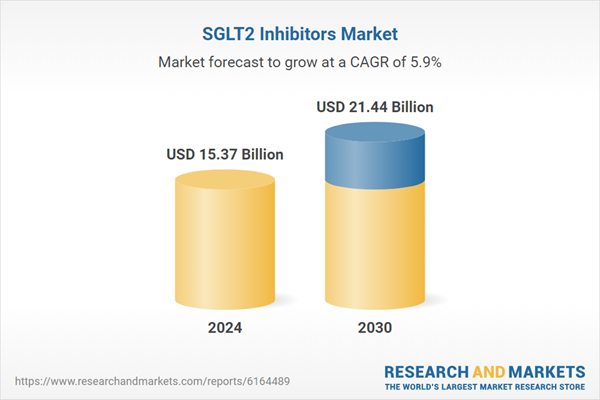Speak directly to the analyst to clarify any post sales queries you may have.
10% Free customizationThis report comes with 10% free customization, enabling you to add data that meets your specific business needs.
Rising diabetes incidence, coupled with growing awareness of the complications associated with poor glycemic control, has led to an expanding patient pool demanding effective and well-tolerated treatment options. Despite robust growth prospects, challenges such as high treatment costs, stringent regulatory requirements, and concerns about side effects including urinary tract infections and ketoacidosis may constrain market expansion to some extent.
Key Market Drivers
Growth in Healthcare Industry
The rapid expansion of the global healthcare industry is a significant catalyst driving growth in the SGLT2 inhibitors market. The global healthcare industry generates annual sales exceeding USD 4 trillion. Its largest and most lucrative segments are pharmaceuticals and biotechnology, with revenues approaching USD 850 billion, followed by medical technology and diagnostics, which exceed USD 400 billion. Increasing investments in healthcare infrastructure, advancements in medical technology, and improved access to quality care are collectively enhancing the diagnosis and management of chronic diseases such as type 2 diabetes mellitus (T2DM), which is the primary indication for SGLT2 inhibitors.Rising healthcare expenditure, particularly in emerging economies, is enabling broader patient access to innovative therapies, including SGLT2 inhibitors. A report from the World Health Organization (WHO) indicates that global health expenditure continued to rise in 2021, the second year of the pandemic, reaching USD 9.8 trillion equivalent to 10.3% of global GDP. This increase was primarily driven by higher government funding and out-of-pocket expenses. Furthermore, the growing emphasis on early diagnosis and comprehensive disease management programs is boosting prescription rates for these novel antidiabetic agents.
Key Market Challenges
High Cost of Therapy
One of the primary challenges facing the global SGLT2 inhibitors market is the high cost of therapy, which can limit patient access and hinder widespread adoption. Despite their proven clinical benefits, SGLT2 inhibitors are often priced at a premium compared to traditional antidiabetic medications, placing a significant financial burden on both patients and healthcare systems, particularly in low- and middle-income countries.The elevated cost is driven by factors such as complex manufacturing processes, ongoing research and development expenditures, and patent protections that limit the availability of lower-cost generic alternatives. This pricing barrier may result in restricted insurance coverage or reimbursement limitations, thereby reducing affordability for a large segment of the diabetic population.
Key Market Trends
Rising Prevalence of Diabetes
The escalating prevalence of diabetes, particularly type 2 diabetes mellitus (T2DM), is a critical trend shaping the trajectory of the global SGLT2 inhibitors market. According to recent epidemiological data, the number of individuals diagnosed with diabetes continues to rise worldwide, driven by factors such as sedentary lifestyles, urbanization, obesity, and aging populations.Diabetes statistics highlight the increasing global burden of the disease on individuals, families, and nations. According to the latest International Diabetes Federation (IDF) Diabetes Atlas (2025), 11.1% or 1 in 9 of adults aged 20-79 are living with diabetes, with more than 40% unaware of their condition. This growing patient pool has intensified the demand for effective and innovative therapeutic options, positioning SGLT2 inhibitors as a preferred class of oral antidiabetic agents. Their ability to improve glycemic control, coupled with additional benefits such as cardiovascular and renal protection, has enhanced their clinical appeal and expanded their use.
Key Market Players
- Boehringer Ingelheim International GmbH
- AstraZeneca
- Merck & Co., Inc.
- Janssen Pharmaceuticals, Inc.
- TheracosBio, LLC
- Lexicon Pharmaceuticals, Inc.
- Eli Lilly and Company
- Bristol-Myers Squibb Company
- Glenmark Pharmaceuticals Ltd.
Report Scope
In this report, the Global SGLT2 Inhibitors Market has been segmented into the following categories, in addition to the industry trends which have also been detailed below:SGLT2 Inhibitors Market, By Drug:
- Jardiance
- Farmiga
- Inpefa
- Invokana
- Others
SGLT2 Inhibitors Market, By Indication:
- Type 2 Diabetes
- Cardiovascular
- Others
SGLT2 Inhibitors Market, By Region:
- North America
- United States
- Canada
- Mexico
- Europe
- France
- United Kingdom
- Italy
- Germany
- Spain
- Asia Pacific
- China
- India
- Japan
- Australia
- South Korea
- South America
- Brazil
- Argentina
- Colombia
- Middle East & Africa
- South Africa
- Saudi Arabia
- UAE
Competitive Landscape
Company Profiles: Detailed analysis of the major companies present in the Global SGLT2 Inhibitors Market.Available Customizations:
With the given market data, the publisher offers customizations according to a company's specific needs. The following customization options are available for the report.Company Information
- Detailed analysis and profiling of additional market players (up to five).
Table of Contents
Companies Mentioned
- Boehringer Ingelheim International GmbH
- AstraZeneca
- Merck & Co., Inc.
- Janssen Pharmaceuticals, Inc.
- TheracosBio, LLC
- Lexicon Pharmaceuticals, Inc.
- Eli Lilly and Company
- Bristol-Myers Squibb Company
- Glenmark Pharmaceuticals Ltd.
Table Information
| Report Attribute | Details |
|---|---|
| No. of Pages | 185 |
| Published | August 2025 |
| Forecast Period | 2024 - 2030 |
| Estimated Market Value ( USD | $ 15.37 Billion |
| Forecasted Market Value ( USD | $ 21.44 Billion |
| Compound Annual Growth Rate | 5.9% |
| Regions Covered | Global |
| No. of Companies Mentioned | 9 |









